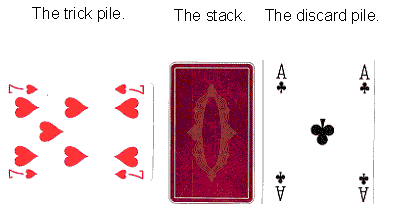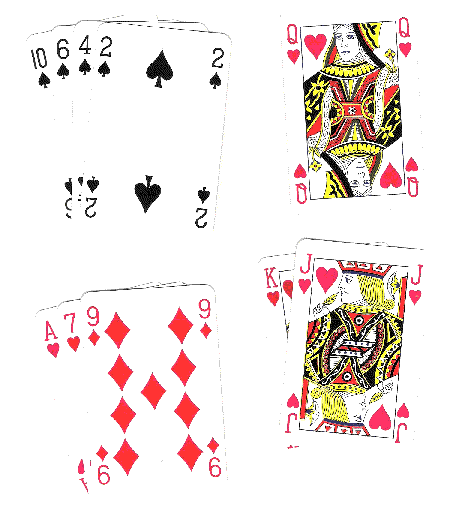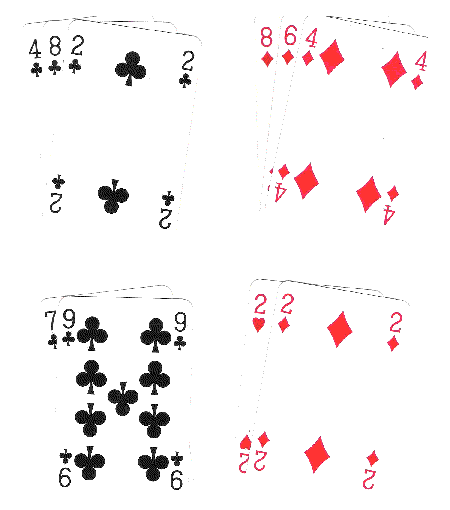Blackbird










A new card game based on the Rummy principle of developing melds of similar cards.
Contributed by Mal Jones © 2005
Official Rules
The rules of the game are written out in a numbered list with headings to ensure clarity. Diagrams are included to aid understanding of the procedures and general rules. Blackbird is basically a straightforward game and with a basic knowledge of Rummy will easily be learned within minutes. The game will help develop basic skills of numeracy, deduction and prediction including other typical card games tactics such as planning and organisation of sets of numbers and sequences.
Four versions are available and all include simple and easily remembered changes of the basic rules.
Blackbird is a game that uses a standard 52-card pack for 2 to 5 players. For more than five players it will be necessary to use two packs of cards.
The deal:
Ten cards for 2, 3 or 4 players (standard game) or eight cards for 5 players.
The remaining cards should be dealt to the table as in (diagram 1), the stack, the discard pile and the trick pile. Play begins starting from the dealers left as is normal. The object of the game is to collect melds (groups of cards) e.g. 4 of one kind, 3 of another, a pair of cards etc and in doing so score points. A single card can also score points. See chart at end.
The value of the cards are as follows Ace is 1; 2, 3, 4 etc to 10 as numbered, Jack as 11, Queen as 12 and King as 13. The first player to dispose of their cards wins the round. All players achieving a display of melds score points. This means that the winner of the round may not on some occasions achieve the highest score.
Basic Rules:
- Opening rule: A card must be picked up from the table to start a turn of play either from the stack, the discard or trick pile. See diagram 1.
- Discard rule #1: A card must be discarded from a hand to complete a turn of play either to the discard pile or to the trick pile.
- Discard rule #2: If a discard is picked up at the start of a turn of play it does not have to be used in that turn to score with.
- Discard rule #3: There must always be at least one card on the trick pile and one card on the discard pile at the end of a turn of play.
- Discard rule #4: When the stack is depleted, the top card from the discard pile should be used to start a new discard pile. The remaining discards should be turned over and now become the new stack.
- The trick card rule #1: The trick card showing at the start of a person’s turn of play determines the scoring possibilities, i.e. what colour and type of cards (odd or even) can be used to score for that particular player’s turn. E.g. if the trick card were a 3 of clubs a meld (group of cards) of odd numbered black cards is required to score such as an Ace, 5 and 7. If the trick card were a Queen of diamonds then an even numbered set of red cards is required to score e.g. 8 and 10 (meld of two cards, or perhaps 2, 4, and Queen (meld of three cards) etc. See scoring charts. See also Game Variations #1 and #2.
- Trick card rule #2: The trick card itself may be used to create a meld. When a trick card is picked up in a turn of play it must be used to create a meld in that turn of play, (two, three or four cards of a particular colour and type constitute a meld). A trick card may not be used to create a score with a singleton. Once a turn is complete the next player will respond to whatever trick card is visible when they take their turn (trick card rule #1). This means that the trick card may change many times in a round of play or game.
Diagram 1: In this example the players have to develop melds of odd numbered Hearts or Diamonds or a mixture of both.

Melds:
- A player may not open their scoring with a single card (singleton). They must display at least a two-card meld before a singleton may be presented.
- A meld is two, three or four of a colour, either odd or even numbered.
- More than one meld can be placed on the table in a turn of play but they must be in accordance with the trick card for that turn of play.
Scoring with melds of cards:
- A meld should be placed on the table directly in front of the player in full view of the other players. Any additional melds or a singleton created during the turn of play or further turns of play should be placed similarly. See diagrams 2 and 3 and scoring chart at end.
Discarding after a scoring display:
- A player who creates a score in a turn of play has the opportunity to change the trick card by discarding a card of their choice onto the trick card pile. Alternatively they may choose not to, keeping the trick card as it was and discarding to the discard pile.
- Where a discard after a scoring turn is a similar type and colour as the current trick card is showing it should be placed on the discard pile, e.g. (trick card showing is an odd numbered red card), a player chooses to discard another odd numbered red card, this should go to the discard pile as it will not change the required scoring tactic). Discarding to the trick pile should change the type and/or colour needed to score with. If it does not it should be discarded to the discard pile. (With rule variation #2 the tricks are suited so this rule will be modified.)
- If the trick pile is emptied during a turn, the player on completion of their turn must discard to the trick pile.
- If the discard card pile is emptied during a turn, the player on completion of their turn must discard to the discard pile.
Scoring with Singletons:
- A singleton although not a meld can score points. Singletons are placed on the table in the normal way.
- Only one singleton is allowed per scoring hand.
- A singleton may not open a player’s scoring display.
- During a turn of play a singleton alone may be displayed as long as the player has a meld of cards present on the table.
Non-scoring turns of play:
- A player who does not score in a turn of play must discard to the discard pile.
End game:
- The player who has used all their cards to create a display and discards their last card to the table wins the round. However the winner of the round may not achieve the highest score for that round. See scoring chart at end.
- The winning player receives bonus points depending on the cards on display. See scoring chart at end.
- All players who have a display on the table score points depending on the number and type of cards on display. See scoring chart at end.
Legal endings for two, three or four players:
- In order to legally win a round a player should have a total of ten scoring cards on display e.g. a meld of 4, 3, 2 and 1 singleton, or melds of 3,3,3, plus 1 or 2,2,2,3,and 1 etc. alternatively 4,4,2 or 4, 2, 2, 2, or 4, 3, 3, or 3,3,2,2, or 2,2,2,2,2. Melds do not have to be developed in any particular order.
Legal endings for five players:
- In order to legally win a round the player must have eight cards on display, e.g. 4,3,1 or 3,2,2,1 or 4,4 or 4,2,2 or 3,3,2 or 2,2,2,2.
Bonus points and endings:
- A player who "goes out" with a set of melds, which includes a singleton, is awarded with 10 bonus points. See diagram 2.
- A player who goes out with a set of melds that does not include a singleton is awarded with a bonus of 5 points. See diagram 3.
Other endings:
- Towards the end of some games, players may realise that the only way to continue scoring is for one or more players to lay a particular suited and numbered card to the trick pile. Unless players are willing to do this, the game becomes un-winnable. When this situation is realised the game ends when the discard pile has been renewed twice. The game ends with the last card of the second turnover.
- The dealer is responsible for acknowledging this situation and for the counting of the discard pile turnovers.
- Where a player accidentally displays a set of melds where it is not legally possible to go out e.g. a display of two melds of 4 and a singleton and a single card in hand, the display is void and the player receives a minus fifty ( - 50) point penalty.
| Scoring Chart: | Meld of 4 | Meld of 3 | Meld of 2 not K J | Singleton not Q | singleton Queen | King and Jack |
|---|---|---|---|---|---|---|
| Spades | 20 | 15 | 10 | 5 | 10 | 20 |
| Diamonds | 16 | 12 | 8 | 4 | 8 | 16 |
| Clubs | 12 | 9 | 6 | 3 | 6 | 12 |
| Hearts | 8 | 6 | 4 | 2 | 4 | 8 |
| Mixed Suit Blacks | 4 | 3 | 2 | n/a | n/a | 2 |
| Mixed Suit Reds | 4 | 3 | 2 | n/a | n/a | 2 |
Displays of melds:
- A meld must be a sequence of cards, which are all odd or all even numbered.
- A meld must be made of cards of the same colour.
- Melds of a pure suit score more than where the suits are mixed.
- A meld of black and red is not legal.
Etiquette of scoring:
- The winner of the round prepares their score first.
- The natural value of the cards including bonuses for a singleton or pairs is noted.
- The bonus for winning the round is added and the score is recorded.
Variations:
- Basic Game variation #1: The basic game and the standard rules apply.
- Game variation #2: Experienced players may wish to restrict scoring possibilities by displaying only melds that are in the suit indicated by the "trick card".
- Game variation #3: In this version trick cards may not removed from the table for use in a meld. However, the trick card pile can still be used to discard to thus changing the next type of scoring meld etc.
- Game variation #4: Uses #2 and #3 together. This variation will further increase the difficulty and duration of a game making winning outright considerably harder.
The value of the suits will remain the same for the variations as for the basic game.
Diagram 2. Example of a displayed hand: meld of 4 black cards in spade suit = 20, meld of 3 mixed red =3, pair of red Jack and King in suit = 8, singleton heart Queen = 4, score =35 plus 10 for having a display with a singleton, total = 45.

Diagram 3. Example of a displayed hand: meld of 3 black clubs = 9, meld of 3 diamonds = 12, meld of 2 clubs = 6 and a pair of mixed red = 2. Score =29 plus bonus for winning hand = 5. Total score = 34.

Basic tactics for playing Blackbird:
Blackbird like other Rummy games is fairly simple to play in its basic form but it has one significant difference that enables each player to dictate how play develops as the game proceeds.
The addition of the trick pile to the Rummy concept enables players to at least partially dictate how scoring melds are developed either by increasing their own chances or minimising their opponents.
In order to control play scoring melds must be placed on the table. Positive bit-by-bit scoring play is more likely to achieve good overall scores over a longer period of time.
Playing the waiting game:
Some players may wish to develop a potentially high scoring set of melds in hand and wait for a suitable trick card to be placed by another player thus allowing them to score at some future point in the game; perhaps even going out within one or two scoring turns of play.
Large scores can be developed in this way but the problem comes when other players after studying the discard pile work out what cards are available for developing the trick pile and hence possible scoring potentials. Some players may prefer to achieve a low score if it means that other players are foiled in their attempt for a high scoring display. There can always be another round to play.
Using the suits to achieve high scores:
The higher the score the suit provides the more likely it is to be a preferred option. With most players chasing the Spades and Diamonds the way is open to build a substantial score and quickly with the lower scoring suits. Gaining a quick win with a ten or five bonus point addition can easily bring a mediocre set of melds up to a potential match winning hand.
Using bonus cards and melds:
Use the bonus cards wisely and do not waste a high scoring Queen of Spades or Diamonds in a meld when it would probably score more as a singleton. The lower scoring Clubs and Hearts provide less bonus points but it is often worth scoring with them rather waste them to the discard pile, so use them in a meld.
The same applies to the Jacks and Kings. It is often better to achieve a low score with a mixed pair of Jack and King rather than give away points to opponents.
Tactics for using the trick pile:
Often the cards in the hand will not develop as wished. It may be necessary for players to discard to the trick or discard pile a card of high value simply in order avoid a stalemate. Where players are chasing the same suits the trick card may remain unchanged for a number of turns of play, for example as players try to regroup the types of cards in their hand. Look out for this situation and force a new trick card on to your opponents. A low scoring meld may result but a few points are better than none.
Using Variation #2 and #3:
The duration of a game is likely to increase with the use of variation #2, as mixed melds cannot be displayed. Variation #3 creates further difficulties as it reduces the numbers of cards that are in use and players will find it increasingly difficult to "go out" with bonus points. Rules 29 and 30 are more likely to be used to complete a game. Both variations 2 and 3 can be used at the same time (Variation #4) and this will make it extremely difficult to complete a table display.
